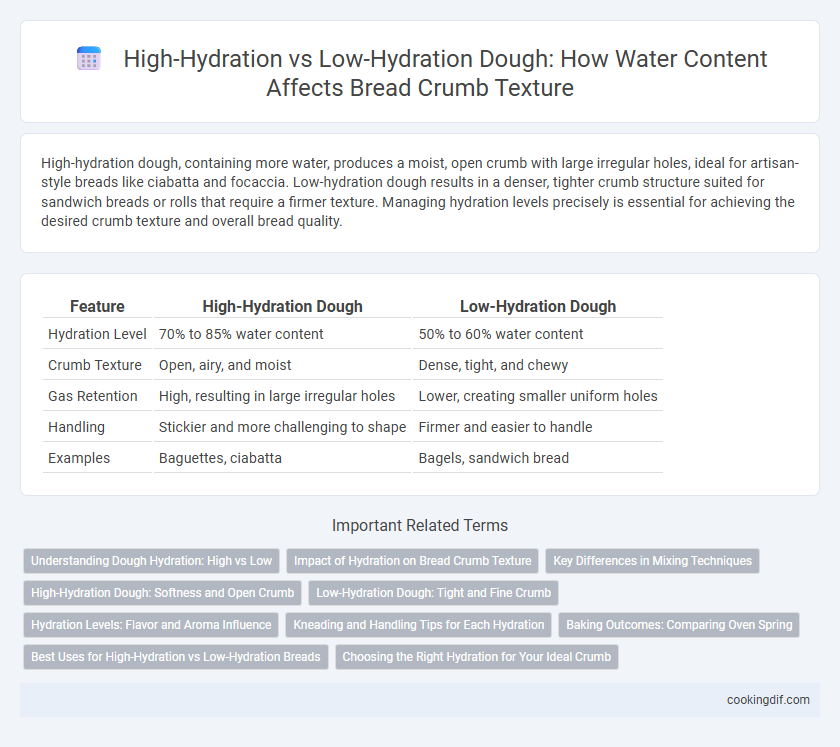High-hydration dough, containing more water, produces a moist, open crumb with large irregular holes, ideal for artisan-style breads like ciabatta and focaccia. Low-hydration dough results in a denser, tighter crumb structure suited for sandwich breads or rolls that require a firmer texture. Managing hydration levels precisely is essential for achieving the desired crumb texture and overall bread quality.
Table of Comparison
| Feature | High-Hydration Dough | Low-Hydration Dough |
|---|---|---|
| Hydration Level | 70% to 85% water content | 50% to 60% water content |
| Crumb Texture | Open, airy, and moist | Dense, tight, and chewy |
| Gas Retention | High, resulting in large irregular holes | Lower, creating smaller uniform holes |
| Handling | Stickier and more challenging to shape | Firmer and easier to handle |
| Examples | Baguettes, ciabatta | Bagels, sandwich bread |
Understanding Dough Hydration: High vs Low
High-hydration doughs, containing 70% or more water relative to flour weight, produce open, airy crumbs with irregular holes favored in artisan breads like ciabatta. Low-hydration doughs, typically below 60%, yield denser, tighter crumbs seen in sandwich loaves and bagels, providing more structured texture and chewiness. Understanding the impact of hydration percentage is crucial for bakers aiming to control crumb softness, density, and moisture retention in their bread products.
Impact of Hydration on Bread Crumb Texture
High-hydration dough, typically containing 70% to 85% water relative to flour weight, produces an open, airy crumb with large, irregular holes due to enhanced gluten development and gas retention. Low-hydration dough, with less than 60% water, results in a denser crumb featuring smaller, uniform holes because reduced moisture limits gluten extensibility and fermentation activity. The hydration level crucially affects crumb texture by regulating dough elasticity, fermentation rate, and oven spring, directly influencing the bread's softness and chewiness.
Key Differences in Mixing Techniques
High-hydration dough requires gentle folding and minimal kneading to maintain its air bubbles, resulting in an open, airy crumb texture. Low-hydration dough demands intensive kneading to develop gluten strength, producing a denser, more uniform crumb. Precise control of hydration levels directly influences mixing techniques and ultimately defines the bread's crumb structure.
High-Hydration Dough: Softness and Open Crumb
High-hydration doughs, containing 70% or more water relative to flour weight, create a soft crumb with an open, airy texture characterized by large, irregular holes. The increased moisture encourages gluten development and fermentation activity, resulting in enhanced extensibility and gas retention during baking. Artisan breads like ciabatta and focaccia exemplify this technique, producing tender, moist crumb structures highly prized for their softness and chewiness.
Low-Hydration Dough: Tight and Fine Crumb
Low-hydration dough typically contains 50-60% water relative to flour weight, resulting in a tight and fine crumb structure. This dough type produces bread with a dense, uniform texture ideal for sandwich loaves and traditional European breads. The limited water content restricts gluten expansion, creating a firm bite and minimal air pockets within the crumb.
Hydration Levels: Flavor and Aroma Influence
High-hydration doughs, typically containing 70% or more water relative to flour weight, promote open, airy crumb textures with larger holes due to enhanced gluten development and fermentation activity. In contrast, low-hydration doughs under 60% yield denser, finer crumb structures with a chewier bite, influencing the bread's overall mouthfeel. Elevated hydration levels also amplify the production of organic acids and flavor compounds, resulting in more complex aroma profiles and improved taste intensity.
Kneading and Handling Tips for Each Hydration
High-hydration doughs, typically containing 75% or more water, produce open, airy crumb textures but require gentle kneading to preserve moisture and elasticity. Low-hydration doughs, with around 60-65% water, benefit from more rigorous kneading to develop gluten structure, resulting in denser, tighter crumbs. For high-hydration dough, use stretch-and-fold techniques and minimal flour to avoid stiffness, while low-hydration doughs tolerate more traditional kneading and less sticky handling.
Baking Outcomes: Comparing Oven Spring
High-hydration dough, containing 70% or more water, creates a more open crumb texture with larger, irregular holes due to enhanced gas retention and steam generation during baking. Low-hydration dough, typically around 50-60% water, yields a denser, tighter crumb structure with less oven spring because of reduced dough extensibility and moisture. Oven spring is significantly greater in high-hydration doughs, resulting in loftier loaves with lighter texture compared to the compact rise of low-hydration counterparts.
Best Uses for High-Hydration vs Low-Hydration Breads
High-hydration doughs, containing 70% or more water relative to flour weight, create open, airy crumb textures ideal for artisan breads like ciabatta and focaccia, which benefit from their moist, chewy interior. Low-hydration doughs, usually below 60% water, yield denser, tighter crumbs perfect for sandwich loaves, bagels, and rolls where a firm structure supports fillings and slicing. Choosing hydration levels directly influences crumb openness, crust thickness, and bread's suitability for specific culinary uses.
Choosing the Right Hydration for Your Ideal Crumb
High-hydration doughs, typically containing 70% or more water relative to flour weight, yield a moist, open crumb with irregular holes favored in artisan breads like ciabatta or focaccia. Low-hydration doughs, usually under 60%, produce a denser, tighter crumb structure ideal for sandwich breads and bagels requiring more chewiness and structure. Selecting the right hydration level depends on the desired crumb texture, balancing dough handling ease with the bread's final moisture and crumb appearance.
High-Hydration Dough vs Low-Hydration Dough for crumb texture Infographic

 cookingdif.com
cookingdif.com